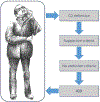Isolated Cervical Dystonia: Diagnosis and Classification
- PMID: 36989390
- PMCID: PMC10528915
- DOI: 10.1002/mds.29387
Isolated Cervical Dystonia: Diagnosis and Classification
Abstract
This document presents a consensus on the diagnosis and classification of isolated cervical dystonia (iCD) with a review of proposed terminology. The International Parkinson and Movement Disorder Society Dystonia Study Group convened a panel of experts to review the main clinical and diagnostic issues related to iCD and to arrive at a consensus on diagnostic criteria and classification. These criteria are intended for use in clinical research, but also may be used to guide clinical practice. The benchmark is expert clinical observation and evaluation. The criteria aim to systematize the use of terminology as well as the diagnostic process, to make it reproducible across centers and applicable by expert and non-expert clinicians. Although motor abnormalities remain central, increasing recognition has been given to nonmotor manifestations, which are incorporated into the current criteria. Three iCD presentations are described in some detail: idiopathic (focal or segmental) iCD, genetic iCD, and acquired iCD. The relationship between iCD and isolated head tremor is also reviewed. Recognition of idiopathic iCD has two levels of certainty, definite or probable, supported by specific diagnostic criteria. Although a probable diagnosis is appropriate for clinical practice, a higher diagnostic level may be required for specific research studies. The consensus retains elements proven valuable in previous criteria and omits aspects that are no longer justified, thereby encapsulating diagnosis according to current knowledge. As understanding of iCD expands, these criteria will need continuous revision to accommodate new advances. © 2023 The Authors. Movement Disorders published by Wiley Periodicals LLC on behalf of International Parkinson and Movement Disorder Society.
Keywords: Dystonia; classification; diagnosis.
© 2023 The Authors. Movement Disorders published by Wiley Periodicals LLC on behalf of International Parkinson and Movement Disorder Society.
Conflict of interest statement
Figures


References
-
- Bressman SB, Warner TT, Almasy L, et al. Exclusion of the DYT1 locus in familial torticollis. Ann Neurol 1996;40(4):681–684. - PubMed
Publication types
MeSH terms
Grants and funding
LinkOut - more resources
Full Text Sources
Medical
Research Materials

